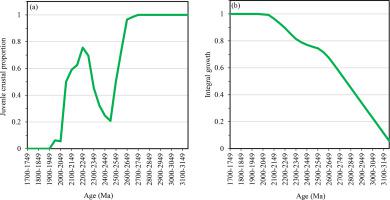当前位置:
X-MOL 学术
›
Gondwana Res.
›
论文详情
Our official English website, www.x-mol.net, welcomes your
feedback! (Note: you will need to create a separate account there.)
Zircon U Pb and Lu Hf isotopes of Huai'an complex granites, North China Craton: Implications for crustal growth, reworking and tectonic evolution
Gondwana Research ( IF 7.2 ) Pub Date : 2021-02-01 , DOI: 10.1016/j.gr.2020.10.015 Min Gao , Zhen-Jie Zhang , Qiu-Ming Cheng , Djordje Grujic
Gondwana Research ( IF 7.2 ) Pub Date : 2021-02-01 , DOI: 10.1016/j.gr.2020.10.015 Min Gao , Zhen-Jie Zhang , Qiu-Ming Cheng , Djordje Grujic

|
Abstract The Huai'an Complex, located in the north-central North China Craton (NCC), consists of tonalite-trondhjemite-granodiorite (TTG) gneisses and minor intrusive bodies of granite. Its late Neoarchean to Paleoproterozoic crustal evolution is still unclear, and the study of this evolution will constrain the tectonic evolution of the NCC. The LA-ICP-MS zircon U Pb ages of ten granites from the Huai'an Complex reveal three episodes of magmatism: 2.6–2.3 Ga, 2.0–1.7 Ga, and a few ages from ~2.3–2.0 Ga. The 2.6–2.3 Ga, 2.3–2.0 Ga and 2.0–1.7 Ga zircons have average eHf(t) values of 2.79, −4.0, and − 6.05, average TDM2 values of 2.78 Ga, 2.98 Ga, and 2.86 Ga, and average 176Lu/177Hf ratios of 0.033, 0.021, and 0.027, respectively, indicating that their magma sources were from the melting of the Neoarchean “mildly depleted” SCLM, the mafic Mesoarchean lower crust, and the mafic Meso-Neoarchean lower crust. Zircon geochemical characteristics indicate that the Huai'an Complex was a long-lived continental magmatic arc during 2.6–2.0 Ga. The juvenile crustal proportion was 100% during 3.1–2.6 Ga and decreased through 50% at 2.5 Ga to 20% at 2.45 Ga; it then increased to 45% at 2.3 Ga and finally decreased to 0% during 1.95–1.7 Ga, indicating that the crust experienced a growth stage during 3.1–2.5 Ga and reworking stage during 2.5–1.7 Ga and that the Huai'an Complex underwent compression-extension-compression processes during 2.6–1.7 Ga. The compression-dominant tectonic setting during 2.6–2.45 Ga may have been linked to the subduction and amalgamation of microblocks. The compressive setting during 2.3–1.7 Ga may have been related to amalgamation between the Eastern and Western Blocks. The modeled crustal growth curve suggests that approximately 67% of the existing continental crust of the Huai'an Complex formed before 2.6 Ga, which is similar to the NCC and several other cratons worldwide. Our results favor the two-stage cratonization model of the NCC.
中文翻译:

华北克拉通淮安复杂花岗岩锆石 U Pb 和 Lu Hf 同位素:对地壳生长、改造和构造演化的意义
摘要 淮安杂岩位于华北克拉通(NCC)中北部,由方长岩-长闪长岩-花岗闪长岩(TTG)片麻岩和少量花岗岩侵入体组成。其新太古代晚期至古元古代地壳演化尚不清楚,对这种演化的研究将制约华北克拉通的构造演化。来自淮安杂岩体的 10 块花岗岩的 LA-ICP-MS 锆石 U Pb 年龄揭示了三个岩浆活动期:2.6-2.3 Ga、2.0-1.7 Ga 和~2.3-2.0 Ga 的几个年龄。2.6-2.3 Ga、2.3-2.0 Ga 和 2.0-1.7 Ga 锆石的平均 eHf(t) 值为 2.79、-4.0 和 - 6.05,平均 TDM2 值为 2.78 Ga、2.98 Ga 和 2.86 Ga,平均 176Lu/177Hf 比值分别为 0.033、0.021 和 0.027,表明它们的岩浆来源来自新太古代“轻度耗竭”SCLM 的熔化,镁铁质中太古代下地壳和镁铁质中-新太古代下地壳。锆石地球化学特征表明,淮安杂岩体在2.6~2.0 Ga为长寿命大陆岩浆弧,3.1~2.6 Ga新生地壳比例为100%,2.5 Ga时由50%下降至2.45 Ga时的20% ; 然后在 2.3 Ga 时增加到 45%,最后在 1.95-1.7 Ga 期间下降到 0%,表明地壳经历了 3.1-2.5 Ga 的生长阶段和 2.5-1.7 Ga 的改造阶段,淮安杂岩经历了2.6-1.7 Ga 期间的压缩-伸展-压缩过程。2.6-2.45 Ga 期间以压缩为主的构造环境可能与微块体的俯冲和合并有关。2.3-1 期间的压缩设置。7 Ga 可能与东、西地块合并有关。模拟的地壳生长曲线表明,淮安杂岩体中约 67% 的现有大陆地壳形成于 2.6 Ga 之前,这与 NCC 和世界其他几个克拉通相似。我们的结果有利于 NCC 的两阶段克拉通化模型。
更新日期:2021-02-01
中文翻译:

华北克拉通淮安复杂花岗岩锆石 U Pb 和 Lu Hf 同位素:对地壳生长、改造和构造演化的意义
摘要 淮安杂岩位于华北克拉通(NCC)中北部,由方长岩-长闪长岩-花岗闪长岩(TTG)片麻岩和少量花岗岩侵入体组成。其新太古代晚期至古元古代地壳演化尚不清楚,对这种演化的研究将制约华北克拉通的构造演化。来自淮安杂岩体的 10 块花岗岩的 LA-ICP-MS 锆石 U Pb 年龄揭示了三个岩浆活动期:2.6-2.3 Ga、2.0-1.7 Ga 和~2.3-2.0 Ga 的几个年龄。2.6-2.3 Ga、2.3-2.0 Ga 和 2.0-1.7 Ga 锆石的平均 eHf(t) 值为 2.79、-4.0 和 - 6.05,平均 TDM2 值为 2.78 Ga、2.98 Ga 和 2.86 Ga,平均 176Lu/177Hf 比值分别为 0.033、0.021 和 0.027,表明它们的岩浆来源来自新太古代“轻度耗竭”SCLM 的熔化,镁铁质中太古代下地壳和镁铁质中-新太古代下地壳。锆石地球化学特征表明,淮安杂岩体在2.6~2.0 Ga为长寿命大陆岩浆弧,3.1~2.6 Ga新生地壳比例为100%,2.5 Ga时由50%下降至2.45 Ga时的20% ; 然后在 2.3 Ga 时增加到 45%,最后在 1.95-1.7 Ga 期间下降到 0%,表明地壳经历了 3.1-2.5 Ga 的生长阶段和 2.5-1.7 Ga 的改造阶段,淮安杂岩经历了2.6-1.7 Ga 期间的压缩-伸展-压缩过程。2.6-2.45 Ga 期间以压缩为主的构造环境可能与微块体的俯冲和合并有关。2.3-1 期间的压缩设置。7 Ga 可能与东、西地块合并有关。模拟的地壳生长曲线表明,淮安杂岩体中约 67% 的现有大陆地壳形成于 2.6 Ga 之前,这与 NCC 和世界其他几个克拉通相似。我们的结果有利于 NCC 的两阶段克拉通化模型。











































 京公网安备 11010802027423号
京公网安备 11010802027423号